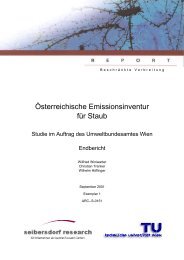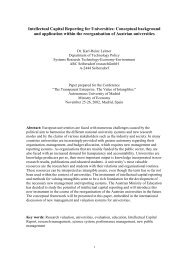ALPMON FINAL REPORT - ARC systems research
ALPMON FINAL REPORT - ARC systems research
ALPMON FINAL REPORT - ARC systems research
Create successful ePaper yourself
Turn your PDF publications into a flip-book with our unique Google optimized e-Paper software.
Contract ENV4-CT96-0359 <strong>ALPMON</strong><br />
use/land cover could be derived from high resolution remote sensing data. It permitted the compilation<br />
of vegetation parameters from which surface roughness can be indirectly deduced.<br />
Land use – forest parameters<br />
The critical parameters concerning land use are mainly forest related. Here, the forest type and crown<br />
closure were of main interest. Additionally, as described above, the separation of special tree species<br />
(larch, dwarf mountain pine, and green alder) was requested. Although the results of forest type<br />
classification (3 types) were very good with a mean accuracy of 92% and a Kappa value of 0.84, the<br />
more detailed classification into 6 types, including three different categories for share of larch tress,<br />
resulted in an accuracy of 68% (Kappa 0.59). Especially the accuracy for the percentage of larch trees<br />
could be significantly improved by the use of SPOT 4 data(see below). The forest density has a<br />
significant influence on the potential of avalanche release. This parameter has been classified in the<br />
Landsat TM satellite data with an accuracy of 85% (Kappa 0.62), for the three canopy closure<br />
categories required by the customer.<br />
Another EC study performed in the Austrian Alps (SEMEFOR, 2000) could demonstrate, that with the<br />
availability of SPOT 4 data the classification accuracy of forest parameters can be improved<br />
significantly. The SPOT 4 sensor delivers images with 20m resolution in the multi-spectral bands and<br />
10m resolution in the panchromatic band. Furthermore, the middle infra-red spectrum has been added,<br />
compared to the former SPOT sensors. The combination of the higher resolution and the availability of<br />
a middle infra-red band proves to be a big advantage with respect to the classification of alpine<br />
vegetation parameters. SPOT 4 data are available on request since 1999. At the moment, it is strongly<br />
recommended to use these data instead of Landsat TM images for a detailed investigation of forest<br />
parameters as well as other Alpine vegetation with respect to the parameters required for avalanche<br />
risk models.<br />
Clearings or small openings within the forest could be detected down to a size of approx. 30m 2 in an<br />
IRS-1D panchromatic winter image. This corresponded with the requirement previously defined by the<br />
customer to detect forest openings with 50m 2 .<br />
Some constraints have to be mentioned concerning two non forest land cover categories. The<br />
requirement of the customer to separate different types of grassland with respect to their use could not<br />
be fulfilled with the available satellite data. The only separation could be made between rich and poor<br />
grassland, which in most cases is related to the meadows in the valleys vs. the alpine pastures above<br />
the forest border line. Furthermore, the rock size could not be classified with these data. This might<br />
become possible with the high resolution sensors, having in mind texture features and the amount of<br />
shadow within a pixel.<br />
In general it can be stated, that areas outside the forest can be classified due to their spectral variation<br />
if they occur on large areas. Smaller areas, which are covered by a mixture of vegetation categories,<br />
such as rhododendron, dwarf mountain pine or smaller moor areas that do not exceed 1 ha, cannot be<br />
classified definitely because of the mixed pixel problem. Simulations have proved that a geometric<br />
resolution of about 5 to 10m in the infrared spectral range is necessary to assess the typical small-area<br />
distribution pattern of vegetation outside of forests. The future sensor <strong>systems</strong> will provide data in this<br />
resolution range.<br />
Roughness parameters which can be indirectly deduced from land use classes<br />
Although the scientific community agrees that surface roughness is a critical parameter for snow<br />
gliding and subsequent snow gliding avalanches, yet, there are no quantifiable measures and rules for<br />
surface roughness available, and roughness parameters of different land cover categories have not<br />
been quantified. This is due to the fact, that avalanche release is a very complicated process,<br />
influenced by the interaction of numerous factors. Nevertheless, roughness parameters such as height<br />
of small bushes and rock size have been defined by the customer as critical parameters. It was clear<br />
from the beginning of the study, that rock size cannot be classified from the available remote sensing<br />
data sources. Although the absolute height of bushes cannot be directly derived from satellite data,<br />
their distribution could be estimated by means of Landsat TM image classification. But, as stated in the<br />
conclusion to the avalanche risk study, smaller areas, which are covered by a mixture of vegetation<br />
categories, cannot be classified definitely because of the mixed pixel problem. A geometric resolution<br />
of about 5 to 10m in the infrared spectral range is required to assess the typical small-area distribution<br />
pattern of alpine vegetation outside of forests. This is also true for the classification of small alpine<br />
bush vegetation.<br />
JR, RSDE, ALU, LMU, Seibersdorf, WSL 82




